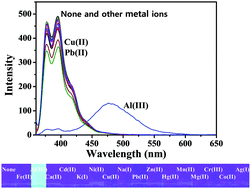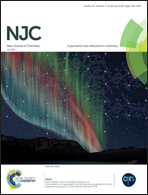Sensitive ratiometric detection of Al(iii) ions in a 100% aqueous buffered solution using a fluorescent probe based on a peptide receptor†
Abstract
Ratiometric detection of Al(III) ions in aqueous buffered solutions is still a significant challenge. Herein, a fluorescent probe 1 based on a dipeptide receptor bearing a pyrene fluorophore was synthesized by solid phase synthesis for the ratiometric detection of Al(III) ions in aqueous solutions. The peptidyl bioprobe detected Al(III) ions sensitively in a 100% aqueous buffered solution through ratiometric response. Upon the addition of Al(III) ions, the excimer emission at 476 nm increased significantly, and the monomer emission at 395 nm decreased considerably. Approximately 3.5 equiv. of Al(III) was required for the complete ratiometric response of 1. Moreover, 1 showed linear responses to nanomolar concentrations (0–500 nM) of Al(III) by change in the intensity ratio of the excimer and monomer emissions. The detection limit of 1 for Al(III) was 138.1 nM (R2 = 0.980) in 100% aqueous solutions. The probe showed highly selective response to Al(III) in the presence of 16 metal ions. The fluorescent peptidyl probe was suitable for the ratiometric detection of Al(III) ions in ground water, tap water, and urine.



 Please wait while we load your content...
Please wait while we load your content...